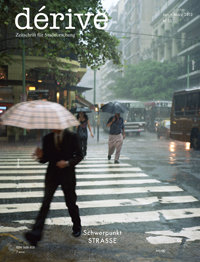Editorial
50 Hefte mit rund 1.100 Beiträgen von mehr als 550 Autoren und Autorinnen sind in den letzten 12,5 Jahren erschienen. Aus der von ein paar FreundInnen in der Freizeit produzierten und privat vorfinanzierten Zeitschrift, die im Vorraum einer WG gelagert wurde, ist mittlerweile eine Publikation geworden, die nicht nur in einem professionelleren Umfeld entsteht, sondern sich auch als angesehenes Fachmagazin im deutschsprachigen Raum etabliert hat, ohne auf gesellschaftspolitisches Engagement zu verzichten. Das Interesse an dérive ist nach wie vor im Steigen begriffen, und die Ideen für neue Themen, Projekte und Kooperationen sind so zahlreich, dass wir stets nur einen Teil davon wirklich umsetzen können. Sie müssen also auch in Zukunft mit uns rechnen, vorausgesetzt natürlich, wir schaffen es, Arbeitskraft und Finanzen entsprechend anzupassen. Zweckdienliche Hinweise und Ideen zur Vereinbarung von Haltung und Gehalt sowie Mithilfe bei der Umsetzung der zahlreichen dérive-Projekte sind jederzeit herzlich willkommen: mail@derive.at.
Das runde Jubiläums-Heft NO50 widmen wir mit einem umfassenden Schwerpunkt der »Straße«: Gehört sie doch zur Geschichte der Stadt wie das Vinyl zur Schallplatte und verlockte an ihren Kreuzungspunkten zu ersten urbanen Ansiedlungen. Straßen dien(t)en der politischen Macht zur Demonstration derselben ebenso wie der Opposition zum Protest. Sie besitzen maßgeblichen Einfluss auf die Ausdehnung unserer Städte und stehen als öffentlicher Raum im Mittelpunkt einer angeregten Debatte, die uns noch etliche Jahre begleiten wird. Denn noch wird Straße in erster Linie als Verkehrsraum gesehen, der vorrangig dem motorisierten Individualverkehr zu dienen hat. Steigende Ölpreise könnten das Ende diese Sichtweise eventuell beschleunigen, wäre da nicht die forcierte Smart-Cities-E-Mobility-Propaganda, die uns einzureden versucht, sämtliche Probleme seien gelöst, wenn Strom- statt Benzin-Autos die Städte zuparken und die Straße weiterhin als bevorzugtes Revier des Individualverkehrs fungiert.
Die Vielzahl an negativen Auswirkungen angestammter Verkehrskonzepte und Fragen an eine mögliche Zukunft urbaner Mobilität stehen daher gleich im Mittelpunkt des ersten Schwerpunkt-Artikels, den Josef Schopf und Günter Emberger vom Forschungsbereich für Verkehrsplanung und Verkehrstechnik der TU Wien dankenswerterweise für dérive verfasst haben. Dass Straße schon immer viel mehr als ein reiner Verkehrsraum war, unterstreicht daraufhin der Kulturwissenschaftler Roman Horak, wenn er sich mit der Straße als Ort und Raum und »hinsichtlich ihres metaphorischen Bedeutungsreichtums« befasst. Die berühmte Street Corner Society ist hierbei ebenso Thema wie Street-Fighting-Men, Maiaufmärsche oder die Party-People der Street Parties unterschiedlichster Prägung. Die wohl bekannteste Verquickung von Straße, Party und Politik war schon einmal Thema in dérive NO2: Sonja Brünzels Artikel Reclaim the Streets: Karneval und Konfrontation findet sich als Ergänzung dieses Schwerpunkts zum Nachlesen auf www.derive.at.
Eine Erweiterung der europäischen Perspektive übernimmt Jonathan Shapiro Anjaria mit seinem Beitrag Is there a culture of the Indian street?, einer Frage, die er exemplarisch anhand von Mumbai zu beantworten versucht. Im Mittelpunkt steht dabei der Konflikt zwischen der von Politik und Medien gewünschten Anpassung indischer Städte an die Standards der Global City und den Bedürfnissen großer Teile der Bevölkerung, für die Straße tatsächlich noch so etwas wie Lebensraum darstellt. Auch Urban mobilities and the cycle rickshaw, der zweite Beitrag zur indischen Straße von Gopa Samanta, kritisiert diese Orientierung: Im Zentrum steht die Rikscha, die in vielen indischen Städten nach wie vor eine wichtige Rolle als Transportmittel spielt und Arbeitsmöglichkeiten bietet.
Theresa Schütz, Mitbegründerin der Gehsteig Guerrilleros, eines aktionistischen und interventionistischen Wiener Raum-Kollektivs, lotet in ihrem Essay das Feld zwischen auf der Straße gehen und auf die Straße gehen aus und kritisiert dabei klassische Planungsansätze, die es nicht schaffen, in Straße mehr als ein »abstraktes System« zu sehen.
Anschließend daran nimmt Manfred Russo die Grundfigur der doppelten Bewegung zwischen schützendem und befreiendem Raum als Ausgangspunkt für seine Abhandlung zur Rolle der städtischen Straße im Zusammenhang mit der Dialektik von öffentlichem und privatem Raum.
Als ganz konkreten Raum hat der Stadtforscher und Historiker Peter Payer die Wiener Opernkreuzung gewählt, um die Umbrüche zu beschreiben, die mit der Durchsetzung der autogerechten Stadt auf die Stadt- und StraßennutzerInnen zukamen. An dieser Stelle sei auch auf die dérive-Radiosendung Wiener Ringstraßenpassagen – Unterirdische Stadträume im Wandel von Shenja von Mannstein und Daniel Spruth (September 2012) verwiesen, die sich der Opernpassage widmet und wunderbare Original-Aufnahmen zur autogerechten Stadt versammelt. Zu finden ist der Beitrag in dérives Cultural Broadcasting Archiv CBA unter http://cba.fro.at/series/1235.
Zu feiern gibt es diesmal aber nicht nur die 50. Ausgabe der Zeitschrift dérive, sondern auch die Nominierung von Radio dérive für den renommierten Radiopreis der Erwachsenenbildung in der Sparte Sendereihen. Gemeinsam mit Radio dérive, als ausschließlich in ehrenamtlicher Arbeit produzierte Sendereihe, rittern die öffentlich-rechtlichen Ö1-Formate Radiokolleg und Journal Panorama um den Preis.
Nachdem wir davon ausgehen, dass die Welt sich auch nach dem 21.12.2012 in gleicher Verrücktheit wie bisher weiter drehen wird, empfehlen wir als Vorsätze fürs Neue Jahr die dérive-Abo-Bestellung oder -Verlängerung (siehe Aktionsangebote S. 2 und S. 64), das regelmäßige Hören von Radio dérive (Podcast!) sowie ein verstärktes Engagement für eine Stadt
für alle.
Es gibt viel zu tun, auf ein Neues, Ihr Christoph Laimer
